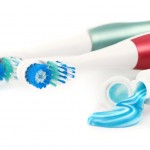
The 2010 Cochrane review of powered toothbrushes (Deacon et al) provided some evidence that rotational oscillation powered toothbrushes are more effective than other designs. However, the available evidence was based on short-term studies and the differences were small, so the clinical importance was unclear. The aim of this study was to investigate the effect of powered toothbrush (PT) compared with manual toothbrushes (MT) on dental plaque in a sample of nursing-home residents.
Patients admitted to long-term care with at least six remaining natural teeth and with stable health were randomly assigned to one of two groups directly after baseline assessment. All patients received the same instructions for use, orally and written in the form of illustrated instructional cards. Those in the intervention group were instructed to use an electric, oscillating, rotating toothbrush and those in the control group a manual brush. The duration of the intervention period was 2 months. The debris index (DI-S) from the Simplified Oral Hygiene Index (OHI-S) was used as a measure of dental hygiene. As an additional measure of dental hygiene to include dentures and gingival inflammation, the mucosal plaque index (MPS) was used. A questionnaire was used to assess the views of caregivers.
- 180 patients were included (86 in PT group, 94 in MT group)
- Ages ranged from 49 -104yr (mean age ± SD = 86.1±7.7 yr)
- 54.4% had ≥20 teeth. The majority performed dental care without assistance (73.3%)
- There was a significant reduction in plaque, as measured by improvement of the plaque score in both groups after the intervention period.
- 152 questionnaire were distributed to caregivers ; 35 (23.0%) were nurses, 75 (49.3%) were auxiliary nurses, 31 (20.4%) were unskilled health workers, and 11 (7.3%) others were involved in the residents’ daily oral care
- 88 (64.7%) caregivers reported that there was either no difference or it was easier to use a PT compared to a MT.
- For residents with dementia 60 (46.5%) caregivers replied that PT was easier or there was no difference
The authors concluded
In a frail population, no difference is found in the effect of PT compared with MT. However, the PT appears to be a useful aid for residents who receive assistance with dental hygiene.
Comment
As with the studies included in the Cochrane review this one was of short duration and it would be interesting to see whether the improvements seen could be maintained in the long term. It would also been interesting to have seen some patient reported outcomes.
Links
Fjeld KG, Mowe M, Eide H, Willumsen T. Effect of electric toothbrush on residents’ oral hygiene: a randomized clinical trial in nursing homes. Eur J Oral Sci. 2014 Jan 20. doi: 10.1111/eos.12113. [Epub ahead of print] PubMed PMID: 24438077.
Deacon SA, Glenny AM, Deery C, Robinson PG, Heanue M, Walmsley AD, Shaw WC. Different powered toothbrushes for plaque control and gingival health. Cochrane Database of Systematic Reviews 2010, Issue 12. Art. No.: CD004971. DOI: 10.1002/14651858.CD004971.pub2.

Nursing home. No difference between electric and manual brush. Electric useful aid when assistance needed. http://t.co/78YoC2dz2u